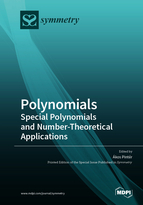Polynomials: Special Polynomials and Number-Theoretical Applications
A special issue of Symmetry (ISSN 2073-8994). This special issue belongs to the section "Mathematics".
Deadline for manuscript submissions: closed (31 July 2020) | Viewed by 23195
Special Issue Editor
Interests: polynomials; diophantine number theory
Special Issues, Collections and Topics in MDPI journals
Special Issue Information
Dear Colleagues,
The polynomials play an important role in mathematics and science. We aim to focus on two applications of these well-known mathematical objects in this Issue: special polynomials and number theory.
The special polynomials (including Bernoulli and Euler polynomials and their generalizations) possess several applications in many branches of pure and applied mathematics. On the other hand, the nth Bernoulli polynomial Bn(X), for example, is a special bridge between certain mathematical topics; we refer here only to the classical formula by Jacob Bernoulli, 1k+2k+… +(x-1)k=1/(k+1)(Bk+1(x)-Bk+1(0))
The application of polynomials in number theory, especially in the theory of diophantine equations, goes back to the famous result of LeVeque from 1964. Let f(X) be a polynomial with rational coefficients, and let r1,…,rn denote the multiplicities of its zeros. LeVeque's theorem states that for given m>1 , the superelliptic equation f(x) = ym in integers x, y has only finitely many solutions, unless {m/(m, r1),…, m/(m, rn)} is a permutation of one of the n-tuples {t, 1,..., 1}, t >0, and {2, 2, 1,..., 1}.
This was an ineffective finiteness result; later, several authors obtained effective versions providing an upper bound for x and y. However, one can see that to apply LeVeque's condition for a broad class of polynomial diophantine equations is a rather hard problem, because we have to determine the structure of zeros of an infinite family of polynomials.
The expected high-level articles should be a novel research contribution or an expository survey article related to the above-mentioned topics touching the role of symmetry.
Prof. Dr. Ákos Pintér
Guest Editor
Manuscript Submission Information
Manuscripts should be submitted online at www.mdpi.com by registering and logging in to this website. Once you are registered, click here to go to the submission form. Manuscripts can be submitted until the deadline. All submissions that pass pre-check are peer-reviewed. Accepted papers will be published continuously in the journal (as soon as accepted) and will be listed together on the special issue website. Research articles, review articles as well as short communications are invited. For planned papers, a title and short abstract (about 100 words) can be sent to the Editorial Office for announcement on this website.
Submitted manuscripts should not have been published previously, nor be under consideration for publication elsewhere (except conference proceedings papers). All manuscripts are thoroughly refereed through a single-blind peer-review process. A guide for authors and other relevant information for submission of manuscripts is available on the Instructions for Authors page. Symmetry is an international peer-reviewed open access monthly journal published by MDPI.
Please visit the Instructions for Authors page before submitting a manuscript. The Article Processing Charge (APC) for publication in this open access journal is 2400 CHF (Swiss Francs). Submitted papers should be well formatted and use good English. Authors may use MDPI's English editing service prior to publication or during author revisions.
Keywords
- Polynomials
- Bernoulli- and Euler polynomials and their generalizations
- Other special polynomials
- Structure of zeros of polynomials
- Polynomial diophantine equations
- Superelliptic diophantine equations
- LeVeque’s theorem
Benefits of Publishing in a Special Issue
- Ease of navigation: Grouping papers by topic helps scholars navigate broad scope journals more efficiently.
- Greater discoverability: Special Issues support the reach and impact of scientific research. Articles in Special Issues are more discoverable and cited more frequently.
- Expansion of research network: Special Issues facilitate connections among authors, fostering scientific collaborations.
- External promotion: Articles in Special Issues are often promoted through the journal's social media, increasing their visibility.
- e-Book format: Special Issues with more than 10 articles can be published as dedicated e-books, ensuring wide and rapid dissemination.
Further information on MDPI's Special Issue policies can be found here.






